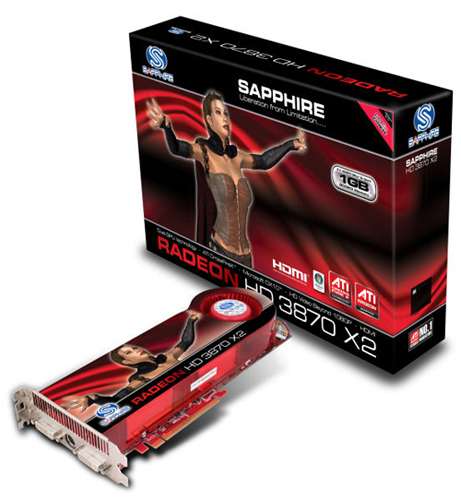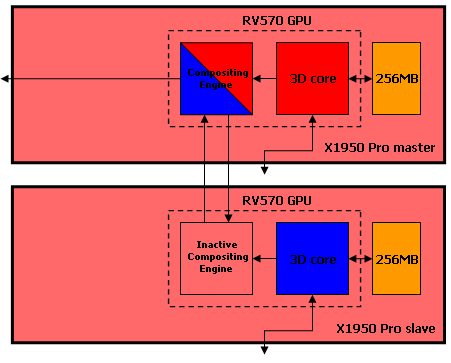Radeon HD 3870 X2

The Radeon HD3870 X2 was a temporary solution that should compete with NVIDIA's older video cards until the appearance of the R700 chip and cards based on it. So, the new video card Radeon HD3870 X2 is positioned as a competitor to the GeForce 8800 Ultra.
The release of the ATI Radeon HD 3870 X2 brought AMD back to mid-2006 where the graphics division of the world's second-largest x86 microprocessor vendor has the ability to sell the world's fastest graphics card for $449.
In fact, the new product does not differ from two ATI Radeon HD 3870s operating in the CrossFire mode except for the clock speeds of the GPU and memory. Theoretically, the ATI Radeon HD 3870 X2 has an impressive potential, allowing it to compete on equal terms with both the Nvidia GeForce 8800 GTX/Ultra and the GeForce 8800 GTS 512MB, however, predicting the performance of multiprocessor graphics systems is a thankless task; a concrete answer about their competitiveness in 3D applications can only be given by practical testing. Before moving on to it, let's try to figure out how the new high-performance ATI video adapter works inside.
The task of combining two ATI RV670 graphic processors operating in CrossFire mode on one board is greatly simplified due to the presence of a hardware Compositing Engine in the core. In the first versions of CrossFire, this block was external and was built on the basis of a separate Xilinx Spartan-3 FPGA; For the first time, the Compositing Engine was integrated into the graphics core in the ATI RV570, the chip that became the heart of the ATI Radeon X1950 Pro. The CrossFire logic diagram began to look like this:

In this case, each GPU uses its own PCI Express bus, which requires, firstly, the presence of two PCIe x16 slots on the motherboard, and secondly, support for CrossFire technology from the system logic set. AMD and Intel chipsets can boast of such support, but not Nvidia, which is not suitable for the ATI Radeon HD 3870 X2, which is positioned as a single graphics adapter. Obviously, it should work on any motherboard with any set of system logic, and, of course, both graphics cores should be involved.
The operation logic of two ATI Radeon HD 3870 X2 processors is no different from the operation logic of two separate ATI Radeon HD 3870 processors combined in CrossFire tandem.
Specifications ATI Radeon HD 3870 X2
| Name | Radeon HD 3870X2 |
| Core | RV670x2 |
| Process technology (µm) | 0.055 |
| Transistors (million) | 666 |
| Core frequency | 825 |
| Memory frequency (DDR) | 900 (1800) |
| Bus and memory type | GDDR3 256bit x2 |
| Bandwidth (Gb/s) | 115.2 (57.6 x2) |
| Unified shader blocks | 320x2 |
| Frequency of unified shader units | 825 |
| TMU per conveyor | 16x2 |
| ROP | 16x2 |
| Shader Model | 4.1 |
| Fill Rate (Mpix/s) | 26400 |
| Fill Rate (Mtex/s) | 26400 |
| DirectX | 10.1 |
| Anti-Aliasing (Max) | MS-24x |
| Anisotropic Filtering (Max) | 16x |
| Memory | 512 x2 |
| Interface | PCI-E 2.0 |
| RAMDAC | 2x400 |
From a technical point of view, the novelty turned out to be a success: the developers managed to fit two RV670 graphics chips with all their accompanying elements on one board, including memory chips and power stabilizers, as well as a rather large PCI Express switch chip, while keeping within the dimensions of the Nvidia GeForce 8800 GTX/Ultra. The relatively low level of heat dissipation of the RV670 and the support of ATI PowerPlay technology by this core made it possible to get by with a simple cooling system that does not even use heat pipes, which have long become a familiar attribute of high-performance graphics cards. On the one hand, the company really managed to create the most powerful single-board graphics adapter that can fight on equal terms with the Nvidia GeForce 8800 GTX/Ultra and GeForce 8800 GTS 512MB, and in some cases even beat them.
bioshock




